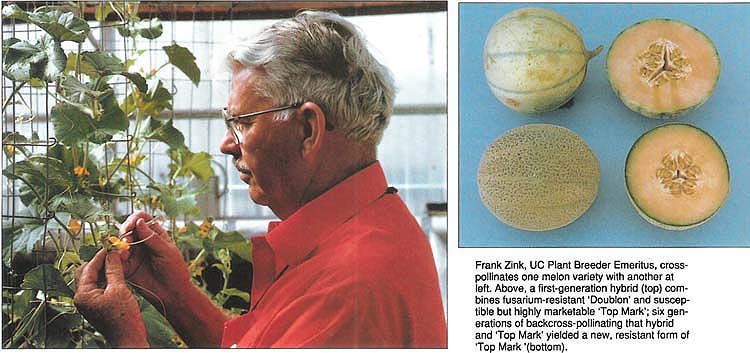All Issues
Resistant germplasm controls Fusarium wilt in cantaloupes
Publication Information
California Agriculture 44(6):27-28.
Published November 01, 1990
PDF | Citation | Permissions
Abstract
Fusarium wilt is widespread, and has caused severe losses to cantaloupe fields in the San Joaquin Valley. Researchers have bred resistant germplasm into orange-fleshed western shipping-type cantaloupes, and resistant F, hybrids are now available for commercial growers.
Full text
Frank Zink, UC Plant Breeder Emeritus, cross-pollinates one melon variety with another at left. Above, a first-generation hybrid (top) combines fusarium-resistant ‘Doublon’ and susceptible but highly marketable ‘Top Mark’; six generations of backcross-pollinating that hybrid and ‘Top Mark’ yielded a new, resistant form of ‘Top Mark’ (bottom).
Fusarium wilt of cantaloupe, caused by Fusarium oxysporum Schlect f. sp. melonis Leach and Currenceemend. Snyd. and Hans., is relatively new to California, having first been found in 1974 in a market garden field in western Riverside County. In 1976, one planting of the PMR 45 variety was severely affected in Fresno County's major production area. Since that time, Fusarium wilt has become progressively more widespread, causing losses in Fresno, Merced, Stanislaus, Kings, and Kern counties. Today it is the most important soilborne disease affecting muskmelon in the San Joaquin Valley.
Fusarium wilt is a vascular wilt disease caused by a soil-inhabiting fungus. The pathogen can survive in the soil for years, and can also be seedborne. Fusarium enters the plant by infecting the roots at any stage of growth.
A heavy soil infestation may result in seedling death before emergence or cause young plants to develop rot and wilt with little external evidence of stem injury. On very young plants, Fusarium can be confused with forms of damping-off caused by other fungi. On older plants, the first visible symptom is a wilting or yellowing of leaves on one or more lateral runners. Wilting occurs rapidly — at first, only a single lateral may be affected, but the entire plant eventually dies. Necrotic lesions appear on one side of the affected stem near the ground line and extend for some distance as long, narrow brown streaks. Plants generally are stunted.
The only practical control now available for Fusarium wilt comes in the form of varieties that are inherently resistant to the pathogen. Though several resistant varieties have been developed for the midwestern and eastern states where the disease has occurred since the 1930s, none of these is acceptable as a western shipping-type cantaloupe, and all are poorly adapted to California production areas.
Methods
Our survey of muskmelon germplasm showed that a number of plant introductions and varieties are highly resistant to the Fusarium races that are present in California (F. oxysporum f. sp. melonis races 0 and 2). We selected two varieties as sources of resistance (the donor parents): ‘Doublon,’ a French orange-fleshed dessert melon; and ‘Perlita,’ an orange-fleshed, netted cantaloupe from Texas. Genetic studies revealed a simple mechanism for inheritance of the disease reaction, with resistance controlled by a dominant gene in ‘Doublon’ and by a second dominant gene in ‘Perlita.’
We initiated four parallel breeding programs to incorporate the donor parents' resistance into two netted, salmon-orange-fleshed western shipping cantaloupe varieties, Top Mark and Gusto 45, which served as the recurrent parents. Controlled crosses were made between the donor parents and the recurrent parents. We screened the first generation for resistance to Fusarium wilt in seedling tests, and crossed selected resistant progenies back to their respective recurrent parents.
We went through six successive backcross generations, selecting for the donor parents' resistance and the recurrent parents' desirable horticultural traits. Progenies from the sixth backcross generation that showed resistance to Fusarium wilt were identified by seedling tests and transplanted into fruit-to-row isolation plots at the West Side Field Station in the San Joaquin Valley. We selected open-pollinated fruit for fruit type and quality and for plant vigor. Seeds from those fruits were saved.
Resistant seedlings grown from seed produced at the West Side Field Station were used to grow an additional generation, using the same breeding procedures at the University Experiment Station in Davis. Selections were made for fruit quality, freedom from crown-blight symptoms, and sulfur resistance in breeding lines with Top Mark as the recurrent parent. A seed sample from each selected fruit was assayed for Fusarium resistance (seedling test).
Resistant seedlings from the second open-pollinated generation of the sixth backcross were transplanted into the Melon Industry Greenhouse at UC Davis and self-pollinated. A seed sample from the fruit of each plant was tested to identify which plants were breeding true for resistance. Seed from these resistant plants was released to the California seed industry.
Through the combined efforts of a plant breeder and a plant pathologist using traditional methods, and with the support of the California Melon Research Board, four resistant western shipping-type cantaloupe lines have been released to date. The first of these advanced breeding lines was made available to seed companies in 1984, just 8 years after the first report of the disease in the San Joaquin Valley. In 1987 and 1988, several resistant commercial F1 hybrids that were developed from UC breeding lines were grown on infested soil and gave excellent protection against the disease. Additional hybrids and resistant open-pollinated varieties resembling Top Mark and PMR 45 will be available to the melon industry for the 1991 growing season.





